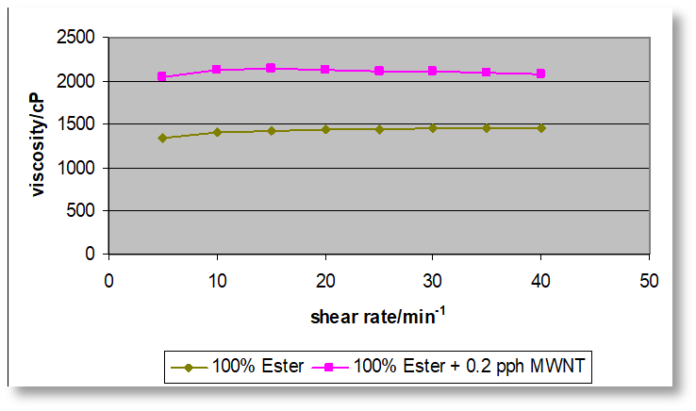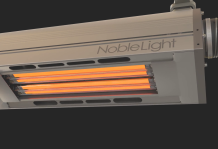In three previous issues of UV+EB Technology, we discussed the preparation of nanocomposites made by incorporating carbon nanotubes (CNTs) into UV-polymerizable formulations. 1, 2, 3 The first two of those articles summarized the experimental techniques developed by undergraduate students at the University of Houston-Downtown to determine how well single-walled carbon nanotubes (SWNTs) were dispersed (exfoliated) into an acrylate-functional medium and the effects observed of the SWNTs on the reactivity and other properties of UV-polymerizable systems. In that initial study, SWNT concentrations ranging from 0.00 to 0.20 pph based on the total mass of the monomers and the oligomer were evaluated. 4 The third article summarized studies of SWNT-containing UV-polymerizable formulations at concentrations from 0.35 to 1.00 pph of the monomer/oligomer mixture. That article also began a discussion of systems containing acrylate-functional urethane and polyester-based formulations containing multi-walled carbon nanotubes (MWNTs) at 0.20 pph. The purpose of this and the next issue of “Professor’s Corner” is to summarize the rheological, thermomechanical (DMA) and thermal (TGA) properties of these MWNT-based formulations.
Properties of UV-Polymerizable Formulations Containing MWNTs
MWNTs are carbon nanotubes containing several concentric, rolled graphene cylinders. Compositionally, they are expected to be much more heterogeneous than SWNTs, both in the number of cylinders per MWNT nanotube and in cylinder length. Because of this, it was expected that they might be more difficult to exfoliate than were the SWNTs. But the student researchers found that using the updated dispersion technique involving enhanced sonication and stirring previously developed for SWNT nanocomposites did produce MWNT-containing nanocomposites that were uniform in appearance and stable with respect to phase separation. 5 However, when cured films of the formulations were prepared and subjected to UV/visible spectroscopy, they did not show the presence of Van Hove singularities. In spite of this, rheological studies, as well as their shelf-life stability, indicated good exfoliation. The heterogeneous nature of the MWNTs, more than likely, explains the absence of clear Van Hove singularities in the spectra.
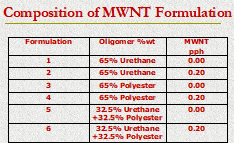
The formulations investigated in this part of the study contained three different oligomer packages, all at 65%-by mass. The first formulation contained the same acrylate-functional urethane oligomer as in the SWNT study. The second one contained an acrylate-functional polyester oligomer, and the third one contained a 50/50-by mass mixture of the two. Table 1 shows the oligomer and MWNT compositions evaluated in this study. Each formulation contained an equal mass mixture of the same three acrylate-functional monomers used in the SWNT study: isobornyl acrylate (IBOA), 1,6-hexanediol diacrylate (HDODA) and trimethylolpropane triacrylate (TMPTA). This monomer mixture represented 35.0%-by mass of the formulation.
Rheological Properties of MWNT-Containing Formulations
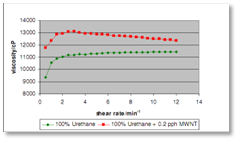
While the SWNT studies involved only a single acrylate-functional urethane oligomer, the study of MWNT-containing formulations was extended to include an acrylate-functional polyester oligomer, along with the urethane-based system. This latter oligomer had a viscosity that was significantly less than that of the former; thus, some differences were observed between the two systems in their rheological properties. See References 4 and 5 for detailed experimental procedures utilized in these studies.
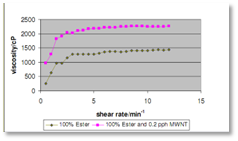
Figures 1, 2 and 3 depict the effects of low shear rates on the viscosity of the urethane-based system, the polyester-based system and the 50/50-by mass blend, along with their corresponding MWNT-containing formulations, respectively. It is obvious that, in each case, the MWNT-containing formulations show a significantly higher viscosity at all shear rates than the corresponding control formulations. This is indicative of strong dipole-induced dipole interactions among the acrylate-functional materials and the MWNTs. These data, along with the excellent shelf-life stability observed, indicate good exfoliation of the MWNTs in spite of the absence of any clear Van Hove singularities being present in the UV/visible spectroscopic experiments. Note that the MWNT-containing formulations in Figures 1 and 3 show maxima in their curves and, after that, both undergo shear thinning. Of course, both of these formulations contain the urethane oligomer. By way of contrast, Figure 2 (which depicts only polyester-based formulations) does not demonstrate shear thinning. Also, note that in all three cases the non-MWNT-containing controls fail to show any shear thinning.
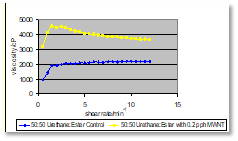
For all six formulations shown in Figures 1, 2 and 3, the data indicate that they are shear thickening at very low shear rates. This seems to demonstrate that, with mixing, the intermolecular attractive forces are increasing with rearrangement of molecules. But this then begins to level off and, for the urethane-based formulations containing MWNTs, it begins to decrease at higher shear rates. This may indicate that the dipole-induced dipole attractions for the 100% polyester-based MWNT-containing formulations are not as easily broken down by shear forces as they are for the urethane-based systems. However, the significantly lower viscosity of this polyester-based system may be having an unexpected effect.
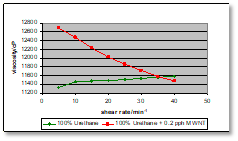
One might ask, then, what happens to the rheological properties at higher shear rates? Figures 4 and 5 show data for the 100% urethane- and 100% polyester-based systems, respectively. These data were recorded at shear rates that still are quite low but are higher than those shown in the previous three figures. Once again, only the urethane-based system shows shear thinning for the MWNT-containing formulation. The polyester-based system appears to be rheologically stable, that is, “Newtonian,” from about 10 revolutions/min (rpm) to 40 rpm.
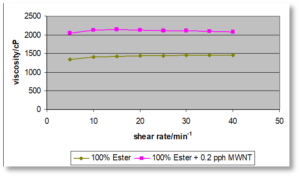
The urethane-based system, by way of contrast, seems to be quite shear-thinning at these higher shear rates. In fact, at 40 rpm, the MWNT-containing formulation actually shows a slightly lower viscosity than does the control. While the polarities of the two oligomers were not measured, these rheological data may indicate that the polarity of the of the acrylate-functional polyester oligomer is greater than that of the urethane acrylate. One might assume that the more polar the oligomer, the stronger would be the ultimate dipole-induced dipole interactions among the oligomer and the MWNTs. This, in turn, would minimize the effect of shear on the system.
In the next issue of “Professor’s Corner,” we will discuss the thermomechanical (DMA) and thermal (TGA) properties of the MWNT nanocomposites.
References
- “Professor’s Corner,” UV+EB Technology, Vol. 9, No. 3, pp. 16 & 17.
- “Professor’s Corner,” UV+EB Technology, Vol. 9, No. 4, pp. 14–16.
- “Professor’s Corner,” UV+EB Technology, Vol.10, No. 2, pp. 12 & 13.
- V. Lam, G. Patino, C. Carandang, & B. Christmas, “UV-Polymerizable Systems Containing Single-Walled Carbon Nanotubes,” http://www.radtech.org/proceedings/2006/papers/093.pdf – Accessed September 28, 2023.
- N. Lam, D. Kurukji, S. Luce & B. Christmas, “Acrylate-Functional Urethane- and Polyester-based Formulations Containing Multi-Walled Carbon Nanotubes,” https://www.radtech.org/proceedings/2008-toc.htm – Accessed February 24, 2024.
 Byron K. Christmas, Ph.D.
Byron K. Christmas, Ph.D.
Professor of Chemistry, Emeritus
University of Houston-Downtown
b4christmas@gmail.com



